Commonly asked questions about soil water and soil management
Author: Graeme Wockner and David Freebairn | Date: 23 Feb 2016
Stubble factors
Does stubble reduce evaporation?
Yes, in the short term because of reduced soil temperatures but any long-term benefits are negated if we have any hot dry weather after rain. Evaporation is the great equaliser (e.g. 8-12mm free water evaporation a day in summer) which can quickly vaporise any moisture in the surface 0-10cm layer. Stubble is still necessary however, to maintain an open surface structure that reduces the formation of a surface seal and promotes the infiltration of rain.
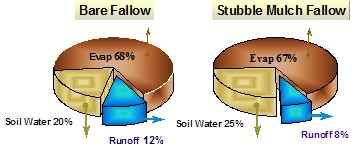
Figure 1. Comparison of two surface management treatments that show only small differences in evaporation but significant differences in soil water infiltration between a bare and a stubble mulch fallow.
Does burying stubble get organic matter into the soil?
Not anymore than leaving it standing. Buried stubble ties up nitrogen in the short term as soil microbes use nitrate for energy to break down the stubble. Above ground, stubble is broken down more slowly by fungi because it is dryer. Eventually the organic matter returns to the ground but in the breakdown process 70% is converted to carbon dioxide.
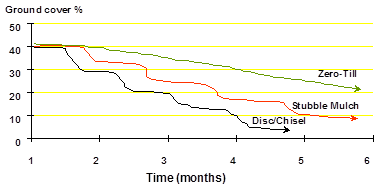
Figure 2. Relationship between time and surface cover breakdown using different tillage instruments
Does burying stubble get more water into the soil than leaving it on the surface?
No, because unless the straw protrudes through the surface infiltration will actually be inhibited. Soil absorbs water like a sponge. You won’t improve a sponge by pushing pieces of straw in it! Straw works best by absorbing the energy of raindrops and preventing the surface of the soil from sealing.
Is it better to leave stubble standing or slash it or knock it over?
A catch 22 question because they both have advantages and disadvantages but it is generally accepted that standing stubble is more effective in erosion control. Stubble laying flat increases the overall cover percentage but most high intensity summer storm rainfall falls at an acute angle so standing stubble absorbs a lot of the rainfall energy. Standing stubble is also rooted in the soil and less likely to be washed downhill. Standing stubble is less likely to clog planters in a no-till farming system than slashed or flattened stubble.
Does organic matter improve soil structure and infiltration?
Yes, but we need a lot of organic matter to make a difference. All soils benefit from increased organic matter but unfortunately this is a slow process. It can take less than 20 years to run soils down but much longer to rebuild good soil structure. Organic matter encourages soil fauna; eg: beetles, ants and worms which effectively improve infiltration.
What is the best way to improve organic matter?
Maintaining or improving soil organic fertility through management practices is an important basis for sustainable farming. A decline in organic carbon is accompanied by degradation of a range of properties important for soil fertility. A pasture phase incorporated into your rotation is probably the best way to build organic matter. No-till farming is also beneficial but takes time to substantially raise levels.
Is a late stubble burn OK with regards to soil erosion?
Yes; with the proviso that we delay it as long as possible (e.g. late April). March traditionally has the highest runoff but not the highest rain. This is because the soil moisture profile at this time is nearly filled to capacity and “when a bucket is full”, water can only run off. If the rain is intense it will take soil with it. The downside of this is that burning is often a more difficult procedure later in the season. If a clean burn is not possible then the use of fire harrows to substantially reduce stubble levels is recommended. Modern no-till machinery is capable of handling large amounts of stubble that don’t require burning.
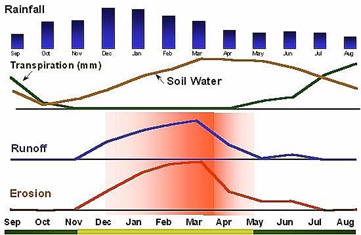
Figure 3. Water dynamics of a summer fallow
Stubble burning is an option available for farmers to control diseases such as yellow spot, minimise nitrogen tie-up in crop residues, and make planting easier with conventional equipment after heavy crops. The 1998 winter wheat crop was severely affected by leaf diseases, and burning was an option for reducing potential carry over of disease. However, in many cases, there is sufficient disease inoculum in the environment to reinfect crops if weather conditions are favourable. Burning a paddock will not remove spores that are present in adjacent grassland for instance.
Bare ground left after burning greatly increases the chance of erosion while reducing the efficiency of water storage during the fallow. If stubble must be burnt, the risk of extreme erosion can be reduced if burning is carried out at an appropriate time. While it is not a prescribed management practice, burning may be practiced from time to time. The key is to understand the risks of runoff and consequent soil erosion.
Other considerations
Will a delay in burning mean it gets too wet to burn!
The risk that a season will turn wet, thus losing an opportunity for a clean burn, needs to be weighed against improved water storage and erosion control. Typically there are many opportunities for a burn through March - April. As a compromise, it may be worth considering burning fewer acres initially.
What if a crop is planted soon after a burn?
If another crop is established quickly, it will provide soil cover, and use soil water (water deficit is the best guarantee for minimising runoff and erosion) thereby minimising the risk of soil erosion.
Will a stubble burn result in less nitrogen tie up?
Generally there is initial less plant available nitrogen when stubble is retained. Over the longer term, losses of organic carbon and nitrogen associated with burning, increased erosion and faster declines in total nitrogen and organic matter in soil eliminate the difference between the two practices.
Will stubble burning reduce disease in other crops?
The main reason to burn is to reduce carry over of yellow spot. Yellow spot mainly affects wheat, so the best strategy to avoid yellow spot is to plant an alternative winter or summer crop in rotation.
Does No-Till promote diseases and pests?
Although some disease organisms grow or survive on stubble, there are strategies to overcome most problems. Rotation of crops is the key. Mice thrive on grain, not stubble - it has too low a feed value, just as it is not preferred by stock. Stubble does provide some protection for mice, but avoiding spilt grain and good farm hygiene are major preventative measures. Complete removal of winter grains can be a challenge in seasons where cereal grains are small or crops lodge.
What can we do when there is no stubble?
Roughness is an option as the increased micro-relief acts as a physical barrier to water movement and increases the entry points for water because of the larger surface area. Results from research work at Wallumbilla show that rough tillage with a chisel plough decreased runoff by 10mm over a summer fallow when compared with smooth scarified tillage.
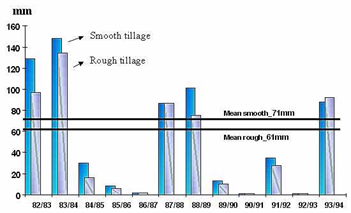
Figure 4. Runoff from smooth and rough tillage treatments at Wallumbilla; Queensland showing the mean 10mm increase in runoff between smooth and rough tillage.
Tillage factors
In controlled traffic can I plough up and down the slope?
Most work in Controlled traffic, which has shown a benefit of up and down working, has been done on fairly low slopes. More work is needed to show the effects on steeper slopes. However, controlled traffic is only successful in reducing erosion in no-till farming systems. In the end, cover is the key to reducing runoff and erosion.
No-till promotes waterlogging and runoff in wet years. Is that so?
Yes and No. Untilled soil with good soil cover increases infiltration and therefore the “bucket” (soil profile) fills sooner. In a wet year because our bucket fills quicker any further rain can only run off or remain on the surface if there is insufficient drainage. Trial work at Greenmount in south-east Queensland has recorded relatively high runoff from no-till treatments sooner in the season than other treatments because the no-till profile filled the quickest. Conversely, in dry years this rapid filling of the bucket gives no-till its big yield advantage.
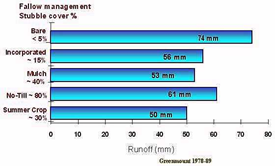
Figure 5. Mean runoff data from Greenmount showing the relatively high runoff from no-till when compared to other treatments.
What effect does herbicide have on worms?
Herbicides (plant killers) should not be confused with insecticides which are sometimes deadly for non-targeted species. The most common herbicides used in no-till systems have no effect on worm populations. Populations of worms in tilled paddocks are usually quite small. Worms and steel ploughs don’t mix.
Is opportunity cropping worth it?
Generally, Yes, in Queensland’s variable climate. Since the 1970’s the best farmers have been saying “Use it or lose it” when talking about soil water. However, opportunity cropping means your farming system must be very flexible. E.g. machinery, seed and long or short crop varieties must be available.
How soon do weeds start having a negative effect on stored moisture?
As a rule of thumb if weeds (e.g. summer grasses)have 8 days to establish, they can then grow at 2-3 centimetres a day. Therefore they are depleting our stored reserves (below 10cm) after 12 days.
Rainfall factors
Are weather forecasts based on the SOI too late to make winter cropping decisions?
The SOI forecast for winter is most accurate after late May. Weather experts have to be conservative in their predictions until they know for sure that the pattern has stabilised. If you keep your own records you can observe weather trends, which allow individuals to make earlier decisions. Weather forecast systems are constantly improving and researchers are confident that earlier, more accurate long-term predictions will eventually be possible.
Is rainfall amount a useful measure of how much soil moisture is stored in the fallow?
Not necessarily, it depends on how much rain fell. Steady rain over several days fills the soil bucket. Sporadic light rain (<15mm in a day) will mostly evaporate if dry days follow. Heavy rain (>50mm in a single storm) will produce runoff. Flood rains may only wet a hard setting soil to a few centimetres.
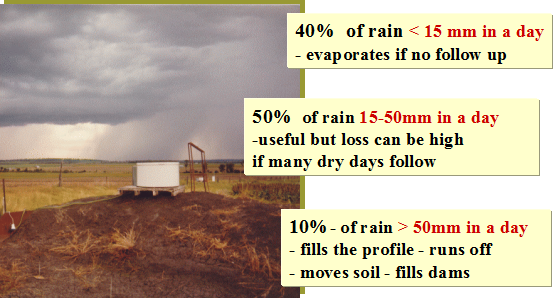
Figure 6. Rainfall fits into different categories
Soil factors
Should nitrogen be applied early or late?
No firm answers because it depends on the season. If we don’t have any rain after we apply early we can have losses. (This may be compensated if nitrogen is cheaper earlier in the season.) Early application means one less job at planting but we might just end up fertilising the early weeds! Nitrogen is extremely mobile and a wet fallow can move it deeper into the profile so a small starter application at planting may be necessary. Some experts feel that banding is best as the growing crop has a better chance of competing for the available N. Top dressing before the flag stage is important because the efficiency of N use drops off dramatically.
Do cracks promote evaporation from the sub soil?
Only in negligible amounts. A soil cracks when it is dry so if a soil is cracked the water has already gone. The crack is more likely to be a net receptor of any storm runoff that a net loser through evaporation. There is little sunlight or air movement in a crack and these are the main causes of evaporation.
Why does my lighter country do better than my heavy country sometimes?
Rainfall on lighter soils infiltrates deeper and more evenly than into a heavy clay but a clay soil holds a lot of water in a small volume of soil. A black earth may hold 18mm of rain per 100mm depth of soil. By contrast, a red earth may only hold 10mm per 100mm or 80% less. Therefore a light fall of rain will only wet a shallow depth of a clay soil but will soak down to a greater depth in a lighter textured soil. This means that light falls of rain on clay soils may evaporate more easily because the water is held close to the surface.
Lighter soils hold water less tightly than a clay soil. Plants can more easily soak up water in a light soil whereas some water in clay soils is not available to plants. Clay soils, then, require more rainfall before plants can extract water from them. This means that plants will respond to light falls of rain better in a light soil. Because clay soils store a greater amount of water, they can supply plants with water longer than light soils when droughty conditions follow good soaking rains.
Can cultivation seal in the moisture?
No. Cultivation turns soil over and exposes moist soil underneath to evaporation. Sometimes a cultivated layer “dust mulch” feels dry while the subsoil feels damp. The surface soil is not sealing in the moisture; it is just evaporating to dryness faster than the sub-soil. At night, when evaporation is less, the dust mulch, too will feel moist as water diffuses from the wetter subsurface to the dry surface.
Contact details
Graeme Wockner and David Freebairn,
Previously Queensland Department of Primary Industries, Natural Resources and many other departmental names. First prepared in 2005.
University of Southern Queensland
West St, Toowoomba Q 4350
Ph: 0408 876 904
Email: david.freebairn@usq.edu.au
Was this page helpful?
YOUR FEEDBACK
